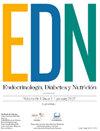跨性别女性和竞技体育:来自内分泌学的考虑。
IF 1.8
4区 医学
Q4 ENDOCRINOLOGY & METABOLISM
引用次数: 0
摘要
导言:变性妇女(TW)参与高水平竞技体育运动的人数逐年增加,体育组织也希望找到既能让她们参与进来,又不损害高水平体育运动公平原则的解决方案。然而,受性激素对身体表现的影响,体育运动的二元分类对将 TW 纳入女性类别造成了挑战。本研究旨在了解性别确认激素疗法(GAHT)对各种运动表现变量的影响,并将结果与在顺性别人群中获得的结果进行比较:方法:回顾包括接受 GAHT 治疗的 TW(最好是运动员)的横断面和纵向研究:结果:接受 GAHT 12 个月后,观察到血细胞比容、血清总睾酮、瘦体重、力量和肌肉面积显著下降,脂肪量增加。与同性女性(CW)相比,TW 的握力在长期内更高。TW在涉及上半身的运动中表现更好:结论:要显著降低雄性激素对各种生理参数的影响,青春期后的 GAHT 至少需要 2 年的时间。GAHT 对身体表现影响的科学证据尚不充分。需要结合新的生物标志物和形态功能参数进行长期研究,以便对 TW 和 CW 在不同项目中的运动表现进行比较。本文章由计算机程序翻译,如有差异,请以英文原文为准。
Transgender women and competitive sports: Considerations from Endocrinology
Introduction
The participation of transgender women (TW) in high-level competitive sports increases every year, as does the interest of sports organizations in finding solutions that allow their inclusion without compromising the principle of equity governing high-level sports. However, the binary categorization of sports, influenced by the impact of sex hormone on physical performance, creates challenges for the inclusion of TW in the female category. This study aimed to understand the impact of gender-affirming hormone therapy (GAHT) on various athletic performance variables and to compare results with those obtained in cisgender populations.
Methods
Review of cross-sectional and longitudinal studies that included TW (preferably athletes) undergoing GAHT.
Results
Significant decreases in hematocrit, total serum testosterone, lean body mass, strength, and muscle area were observed after 12 mo of GAHT, with increases in fat mass. Grip strength was higher in TW compared to cisgender females (CW) in the long term. TW showed better performance in sports involving the upper body.
Conclusions
At least 2 years of postpubertal GAHT are necessary to achieve a significant reduction in the effects of male hormones on various physiological parameters. The scientific evidence regarding the impact of GAHT on physical performance is insufficient. Long-term studies are needed, incorporating new biomarkers and morphofunctional parameters, to allow for comparisons of athletic performance across different disciplines between TW and CW.
求助全文
通过发布文献求助,成功后即可免费获取论文全文。
去求助
来源期刊

Endocrinologia Diabetes Y Nutricion
Multiple-
CiteScore
2.10
自引率
10.50%
发文量
99
期刊介绍:
Endocrinología, Diabetes y Nutrición is the official journal of the Spanish Society of Endocrinology and Nutrition (Sociedad Española de Endocrinología y Nutrición, SEEN) and the Spanish Society of Diabetes (Sociedad Española de Diabetes, SED), and was founded in 1954.
The aim of the journal is to improve knowledge and be a useful tool in practice for clinical and laboratory specialists, trainee physicians, researchers, and nurses interested in endocrinology, diabetes, nutrition and related disciplines.
It is an international journal published in Spanish (print and online) and English (online), covering different fields of endocrinology and metabolism, including diabetes, obesity, and nutrition disorders, as well as the most relevant research produced mainly in Spanish language territories.
The quality of the contents is ensured by a prestigious national and international board, and by a selected panel of specialists involved in a rigorous peer review. The result is that only manuscripts containing high quality research and with utmost interest for clinicians and professionals related in the field are published.
The Journal publishes Original clinical and research articles, Reviews, Special articles, Clinical Guidelines, Position Statements from both societies and Letters to the editor.
Endocrinología, Diabetes y Nutrición can be found at Science Citation Index Expanded, Medline/PubMed and SCOPUS.
 求助内容:
求助内容: 应助结果提醒方式:
应助结果提醒方式:


